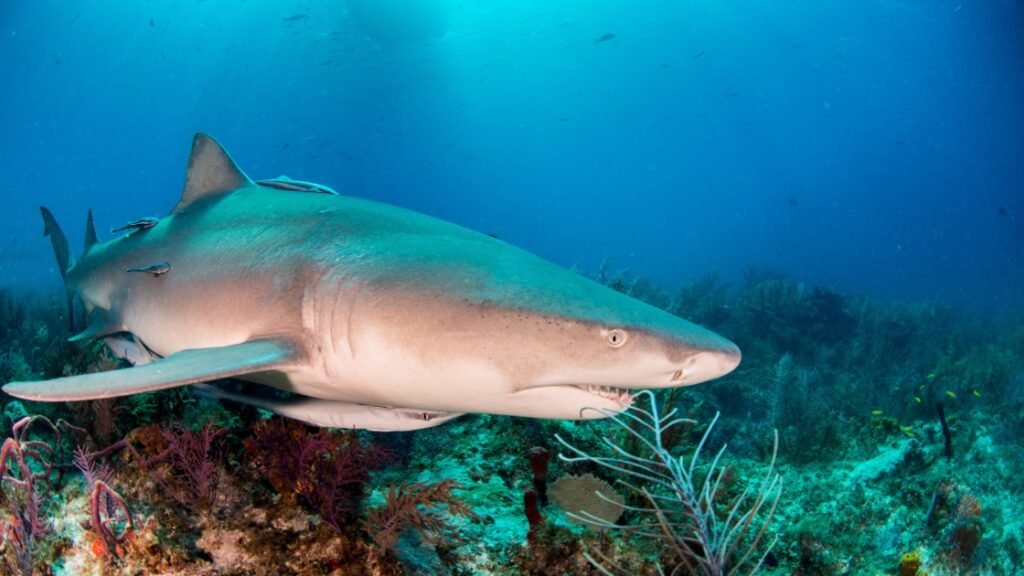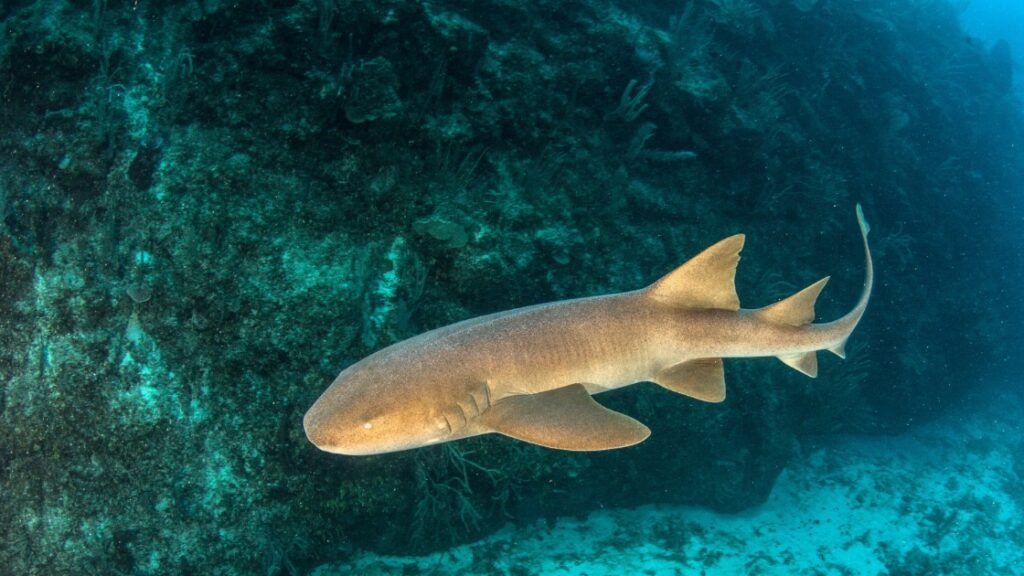The waters of Tampa Bay in Florida are home to a diverse array of shark species. Here are 8 of the most common types of sharks found in the bay and along the Gulf Coast.
Bull Shark

The bull shark (Carcharhinus leucas) is one of the most common and well-known shark species in Tampa Bay. They are large, aggressive sharks that can tolerate fresh water and have been known to swim up rivers. Bull sharks get their name from their short, blunt snout and tendency to head-butt prey before attacking.
“The bull shark is probably the most dangerous shark in the world since it swims in very shallow waters and is found in rivers and estuaries.” [1]
Blacktip Shark

Blacktip sharks (Carcharhinus limbatus) are fast, active predators that get their name from the distinctive black tips on their fins. They feed on small fish like mullet, croakers, and anchovies. Blacktip sharks are among the most abundant shark species in nearshore waters around Florida.
identification guide for blacktip sharks
Lemon Shark

The lemon shark (Negaprion brevirostris) is a stocky, yellowish shark found in shallow subtropical waters. Lemon sharks give birth to live young and the bay provides ideal nursery habitat. These sharks eat fish, crustaceans, and other sharks. Lemon sharks got their name from their faint yellow coloring.
“Popular game fish like redfish, snook, and trout also attract lemon sharks looking for an easy meal.” [2]
More on lemon shark biology and conservation
Atlantic Sharpnose Shark

The Atlantic sharpnose shark (Rhizoprionodon terraenovae) is a small coastal shark reaching about 3 feet in length. They are abundant in estuaries and shallow waters of the Gulf of Mexico. Sharpnose sharks have a distinctly pointed snout. They primarily eat small fish, shrimp, and crabs.
Sharpnose shark identification and fishing regulations
Bonnethead Shark

The bonnethead (Sphyrna tiburo) is a small hammerhead shark found in shallow seagrass habitats. Bonnetheads are grey and reach about 5 feet long. They feed on crustaceans like blue crabs, shrimp, and squid. The unique, shovel-shaped head of bonnethead sharks allows them to find and dig out prey buried in the seafloor.
“Despite their appearance, bonnethead sharks are not considered dangerous to humans.” [3]
Bonnethead shark facts and photos
Spinner Shark

The spinner shark (Carcharhinus brevipinna) gets its name from its impressive aerial displays, leaping and spinning out of the water while hunting fish. They have slender bodies and long, pointed nose. Spinner sharks often follow schools of fish into shallow estuaries and bays. These fast-swimming sharks grow over 9 feet long.
Watch video of spinner sharks jumping
Nurse Shark

The nurse shark (Ginglymostoma cirratum) is a large-bodied shark reaching over 10 feet in length. They are found resting on the bottom in shallow, coastal waters. Nurse sharks have small barbels that resemble whiskers near their mouths. They feed on crustaceans, fish, squid, and urchins. Nurse sharks are not aggressive towards humans unless provoked.
Nurse shark identification guide
FAQ:
What is the most dangerous shark in Tampa Bay?
The bull shark is considered the most dangerous shark found in Tampa Bay due to its large size and aggressive tendencies. Bull sharks have been responsible for attacks on humans in the region.
Where are sharks most commonly found around Tampa Bay?
Sharks are most abundant along the shallow coastlines, in estuaries, and near underwater structures and reefs. The southwestern end of Tampa Bay near the mouth of the bay has a high concentration of sharks.
What should I do if I see a shark while swimming in Tampa Bay?
Leave the water quickly but calmly. Do not provoke or harass the shark. Report any shark sightings to lifeguards or officials. Avoid swimming near fishing activity or at dusk when sharks are most active.
How can I identify different shark species?
Shark species can be identified by distinct characteristics like shape of the snout, fin markings, size, and behavior. For example, the hammerhead shape distinguishes bonnetheads, while blacktip sharks have dark tips on their fins.
In conclusion, Tampa Bay’s warm, shallow waters support a high abundance and diversity of shark species. While shark encounters are rare, it is important to be aware of the risks and know how to stay safe while enjoying Tampa Bay. Most sharks are not a threat if left alone. Appreciating sharks from a distance allows us to safely observe these incredible creatures in their natural habitats.
Tampa Bay is home to a wide variety of shark species, which can be a source of awe and excitement for many. There are a few common species of shark that inhabit the waters of Tampa Bay and its surrounding areas. For those interested in learning more about shark species, here is a brief overview of the eight types of sharks that can be found in Tampa Bay.
The first type of shark is the Bull Shark. The Bull Shark can easily be recognized by its distinctive brown-gray coloring and stocky body. This species of shark is known to favor shallow waters and can occasionally be seen within Tampa Bay.
The second type of shark is the Blacktip Shark. This type of shark prefers shallow coastal waters and usually has a darker gray body. This species of shark can often be seen near the shore, particularly during summer months.
The third type of shark is the Hammerhead Shark. The Hammerhead is easily recognizable due to its distinctive head shape, with two eyes on either side. It inhabits the deeper waters of Tampa Bay, usually at depths of around 100 feet.
The fourth type of shark is the Nurse Shark. This species of shark is usually found in shallow, sandy coastal waters, typically around the western side of Tampa Bay. Nurse Sharks are predominantly brown in color and can be identified by their broad, flattened heads.
The fifth type of shark is the Spinner Shark. This particular species is identified by its light silver-gray coloring and slender body shape. The Spinner Shark prefers to inhabit the open waters of the bay and is known to favor offshore feeding grounds.
The sixth type of shark is the Thresher Shark. This species usually has a light gray coloration with a long tail. The Thresher Shark is usually found in the deeper waters near offshore reefs and is not commonly seen in Tampa Bay.
The seventh type of shark is the Tiger Shark. This species of shark is identified by its distinct black stripes and can usually be found at depths of approximately 150 feet. This species is known to frequent the unstructured sandbars of the bay, near the shorelines.
The final type of shark is the Lemon Shark. Lemon Sharks are usually silver in color and can be identified by their relatively long bodies. This species is often found near the grassy bays of Tampa Bay and can occasionally be spotted near the shore.
All eight species of shark mentioned in this article can be found in and around Tampa Bay. Whether you are an experienced diver or a novice, it is important to remember to be respectful of shark-filled waters and to enjoy the unique species that inhabit them.




